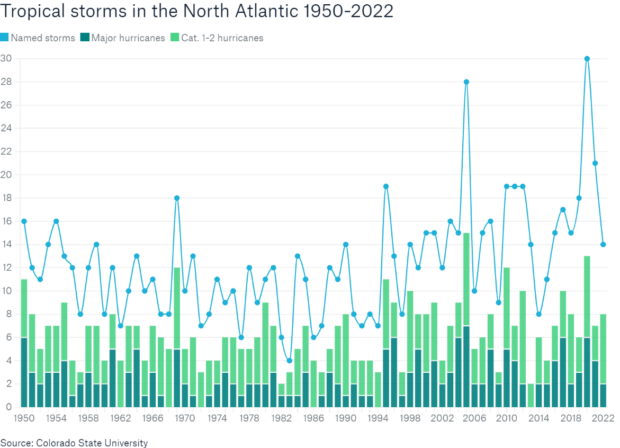The North Atlantic could see 12 named storms this hurricane season, according to a newly released outlook by Munich Re.
Six of the 12 named storms could develop into hurricanes, with two having the potential to develop into severe hurricanes (speeds up to 110 mph), Munich Re’s 2023 Hurricane Outlook further predicted.
Related articles: NOAA: Average Hurricane Season Predicted for the Atlantic; Atlantic Hurricane Season Odds Dependent on El Nino Versus Hot Ocean Temps
The reinsurer’s annual report outlined two conflicting weather patterns that will impact the hurricane season, which begins on June 1 and runs through November 30.
The first is anticipated warmer-than-average ocean temperatures in the North Atlantic coinciding with a strong El Niño phase in the Pacific.
Following three consecutive years with La Niña weather patterns which typically favor hurricanes, this year’s predictions will be influenced by an El Niño weather pattern and warmer than normal ocean temperatures.
Anticipated sea surface temperatures of up to 1°C above average are expected during the main months of hurricane activity from August to October this year.
Temperatures in the tropical North Atlantic are already significantly higher than normal, the report noted.
A warmer than usual tropical North Atlantic may create more favorable conditions for the development and intensification of hurricanes. It also ensures lower air pressure and weaker trade winds, the report stated, contributing to an environment favoring hurricanes.
As noted by the report, El Niño tends to inhibit the formation of hurricanes but higher than normal ocean temperatures in the North Atlantic could fuel cyclones.
Even though an El Niño system imposes temperature swings in the Pacific, it exerts a strong influence on extreme weather in very distant regions, the report added.
El Niño years are accompanied by strong winds at high altitude over the North Atlantic. “Known as vertical wind shear, which inhibits cyclones because it literally tears storm systems apart,” the report stated.
Current forecasts suggest vertical wind shear will likely increase to a high level during the main period of the hurricane season.
Munich Re’s prediction is in line with other forecasts for the season along with long term average hurricane activity measured between 1950 to 2022 (12.2 named storms, of which 6.4 were hurricanes and 2.6 major hurricanes).

According to the reinsurer, since the mid-1990’s, “storm activity during the cyclical warm phase in the North Atlantic has been slightly higher than this, with an average of 15.7 tropical storms, of which 7.7 were hurricanes and 3.6 major hurricanes.”
Speculation still exists as to whether climate change is impacting hurricane activity.
“Caution is advised this year as the signals are conflicting. El Niño will have an impact on extreme weather throughout the world, and may possibly inhibit cyclones,” said Anja Rädler, meteorologist and climate expert at Munich Re. “But due to the higher sea surface temperatures, everything may be happening at an entirely different level. This can still produce devastating storms in what is an otherwise inhibiting environment. Higher sea surface temperatures are one of the consequences of climate change.”
Last year, of the 14 tropical cyclones that were recorded in the North Atlantic, six became hurricanes and two grew to category 3–5, which are considered major hurricanes, the report stated.
With models predicting a strong El Niño phase for the late summer with relative certainty, the level of hurricane activity will depend heavily on the current high ocean temperatures, making it a highly unpredictable year, Munich Re added.




















 The Future of Knowledge in Insurance: From Training to AI-Powered Productivity
The Future of Knowledge in Insurance: From Training to AI-Powered Productivity  Legal Finance and Insurance: From Confusion to Collaboration
Legal Finance and Insurance: From Confusion to Collaboration  Artificial Intelligence Is Rewriting the Rules for Commercial Lines
Artificial Intelligence Is Rewriting the Rules for Commercial Lines  AI in Property/Casualty Insurance: Why Trusted Data Is the Missing Link
AI in Property/Casualty Insurance: Why Trusted Data Is the Missing Link 
